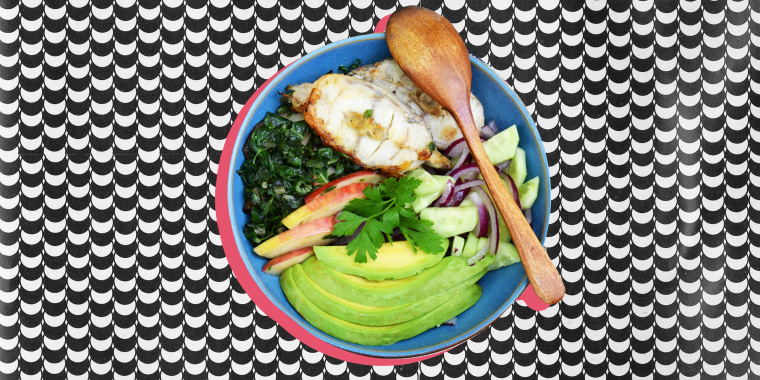Suppose you have an autoimmune disease like rheumatoid arthritis, lupus, Hashimoto's disease, or inflammatory bowel disease. In that case, you’re probably on the lookout for treatments that can help keep your symptoms under control.
The autoimmune protocol (AIP) diet aims to do just that — reduce the pain, fatigue and inflammation that accompany autoimmune disorders.
How does the AIP diet work?
There are a lot of different factors that can cause autoimmune disorders. One of those factors may be “leaky gut,” a condition where toxins and bacteria can pass through the intestines and into the bloodstream. (There’s controversy in the medical community as to whether leaky gut is an actual condition.)
The AIP diet plan eliminates foods that could make your gut more permeable, or leaky. Instead, you choose foods that support gut health and help reduce inflammation.
What does the research say about the AIP diet?
Some studies have found benefits to the autoimmune diet. A 2017 study of 15 people for 11 weeks saw improvements in inflammatory bowel disease. And a 2019 study of 17 people for ten weeks found improvements in symptoms of Hashimoto's disease.
But so far, research on the AIP diet results examine a small sample size for a relatively short time. “All the studies have been done on a small number of people. So you don’t get statistical analysis very easily,” Robert Hylland, MD, a rheumatologist with Rheumatology Centers of Western Michigan, told TODAY. “Most of the studies go out only a few weeks or up to three or six months.”
Is the AIP diet a good choice for you?
If you have an autoimmune condition, you might want to give it a try. The elimination phase of the AIP diet can be tough to stick to, though, since you need to avoid a long list of foods. “Many of my patients just don’t see that that kind of discipline is worth the outcome,” Dr. Hylland said.
Eating out can also be problematic. “It can be next to impossible to follow if you want to have a full social life,” Samantha Cassetty, a registered dietitian based in New York City and the coauthor of “Sugar Shock,” told TODAY.
Cassetty, who has rheumatoid arthritis, tried the AIP diet herself. “It eliminated some of the foods I enjoy routinely and I think of as quite nourishing,” she said. “The stress an elimination diet adds to your life is a big deal.” And she didn’t notice any changes in her symptoms before and after the AIP diet.
She acknowledged that some people do feel better after an AIP diet. “It could be the protocol, or it could be that they were eating very poorly beforehand and, by choosing more whole foods, they have more energy and feel better,” she said.
There aren’t likely AIP diet side effects, but you want to make sure you don’t stay on the elimination phase of the diet for too long since you could develop nutritional deficiencies.
Dr. Hylland said that his patients who are overweight often benefit from diets that promote weight loss. “We know that heavier people with any form of arthritis or any autoimmune diseases have higher levels of disability. They have higher levels of pain. They tend to have poorer sleep,” he said.
He often points them toward the Mediterranean diet or the South Beach Diet. “They aren’t elimination diets. They are adjustment diets,” he said. “You can live on those quite nicely for a long time.”
What do you eat on the AIP diet?
You can think of the AIP diet as a strict version of the paleo diet combined with an elimination diet. For about a month, you eliminate foods that could trigger your symptoms. Then you gradually add those foods back into your diet one at a time to see how your body reacts.
On the AIP diet food list, you eat lean meat, seafood, liver, bone broth, many vegetables, fruit, yogurt and other fermented foods, and some oils.
What’s not on the AIP diet list? You eliminate grains, dairy and eggs, nightshade vegetables (tomatoes, potatoes, peppers and eggplant), seeds and nuts, legumes, coffee, alcohol, processed oils, refined and artificial sugars, and food additives.
You slowly add those foods back into your diet, watching for any flares in your symptoms for several days. You can incorporate foods back into your diet if they don’t cause problems and continue to avoid the ones that do.
You can search online to find examples of AIP diet recipes, AIP meal plans, AIP diet reviews, and vegetarian AIP diets.
Following the AIP diet, in a typical day, you might eat:
- AIP diet breakfast: Ham and spinach sauté
- AIP diet lunch: Shrimp over “zoodles” (zucchini noodles)
- AIP diet dinner: Chicken thighs with asparagus
- AIP diet snack: Melon with honey
The AIP diet is similar to:
- Paleo, which excludes many of the same foods as the AIP diet.
- Whole 30, which also excludes grains, legumes, dairy and sugar.
- Keto diet, which also excludes whole grains and legumes. The diet allows dairy, but not fruit or starchy vegetables.
- Pegan diet, which combines the principles of the paleo diet and the vegan diet.
- Atkins diet, which limits but doesn’t eliminate grains, legumes and sugar.
Is the AIP diet effective long-term?
The AIP diet isn’t intended to be a long-term diet plan, at least not in the elimination phase. It’s designed to help you identify and eliminate only those foods that trigger symptoms in your autoimmune disease.
Related:




